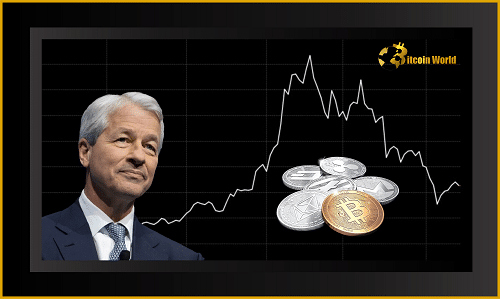Is the crypto payment hype fading? It seems so, at least according to recent insights from banking giant JPMorgan Chase. While the dream of paying for your morning coffee with Bitcoin might be taking a backseat for now, the underlying technology powering cryptocurrencies – blockchain – is far from being dismissed. Let’s dive into what JPMorgan’s global head of payments, Takis Georgakopoulos, had to say about the current state of crypto payments and the future JPMorgan envisions in the digital currency landscape.
Crypto Payments: From Hot Trend to Cooler Reality?
In a recent interview with Bloomberg Television, Takis Georgakopoulos, the global head of payments at JPMorgan Chase, dropped a notable observation: the demand for cryptocurrencies as a payment method has significantly decreased in the past half-year. This comes from a major player in the traditional finance world, offering a valuable perspective on the evolving crypto narrative.
He stated quite plainly:
- “When it comes to crypto as a payment method, we have a lot of demand for our clients, let’s say up until six months ago.”
- “We see very little right now.”
This statement reflects a potential shift in the crypto space. Remember the buzz around using crypto for everyday transactions? It appears that enthusiasm might be waning, at least for now. This cooling trend coincides with market fluctuations; as Georgakopoulos pointed out, Bitcoin’s price, a bellwether for the crypto market, has plunged by over 55% in the last six months according to CoinGecko.
Why the Dip in Crypto Payment Demand?
Several factors could be contributing to this decreased demand:
- Market Volatility: The inherent price swings in cryptocurrencies like Bitcoin make them less appealing for everyday transactions. Imagine buying a coffee with Bitcoin and it’s worth significantly less (or more!) by the time you finish your cup.
- Regulatory Uncertainty: The evolving regulatory landscape surrounding cryptocurrencies can create hesitation for both businesses and consumers considering crypto payments.
- Scalability and Transaction Fees: While improvements are being made, some cryptocurrencies still face challenges with transaction speed and fees, hindering their practicality for widespread payment adoption.
- User Experience: For the average consumer, using traditional payment methods is still often simpler and more familiar than navigating crypto wallets and transactions.
JPMorgan’s Stance: Cautious but Still Crypto-Curious
Despite the dip in payment demand, JPMorgan isn’t turning its back on crypto entirely. Georgakopoulos clarified that the bank continues to support clients who wish to use cryptocurrencies, but with a focus on managing risk. They are “avoiding principle risk on the assets” and view current crypto payment use cases as “limited, at least for now.”
However, it’s crucial to note JPMorgan’s broader perspective. They still see cryptocurrencies as having potential as “an alternative payment in the future.” Georgakopoulos highlighted both the advantages and challenges of crypto compared to traditional payment methods.
The Upsides and Downsides: JPMorgan’s Crypto Payment Balance Sheet
According to Georgakopoulos, cryptocurrencies offer certain intrinsic benefits:
- Information Transmission: Cryptocurrencies can facilitate the transfer of data and information alongside payments, potentially streamlining processes.
- Security: Blockchain technology, underpinning most cryptocurrencies, offers robust security features.
- Privacy: Certain cryptocurrencies offer enhanced privacy compared to traditional payment systems, although regulatory scrutiny in this area is increasing.
These advantages are significant and likely fuel JPMorgan’s continued interest in the space.
JPMorgan’s Crypto Game Plan: Beyond Payments
So, if crypto payments are currently in a lull, what’s JPMorgan’s crypto strategy? It’s clear they are playing the long game, focusing on the foundational technology and future possibilities. Here’s a glimpse into their approach:
- Investing in Crypto Initiatives: JPMorgan continues to invest in cryptocurrency ventures, demonstrating their belief in the technology’s long-term potential.
- Tracking CBDCs: They are closely monitoring the development of central bank digital currencies (CBDCs), recognizing their potential to reshape the financial landscape.
- Onyx Blockchain Network: JPMorgan is building its own blockchain network, Onyx, designed to handle both fiat currencies and future digital currencies, including CBDCs. This infrastructure could be crucial for future payment innovations.
- Blockchain for Traditional Finance: Beyond payments, JPMorgan is exploring blockchain’s application in traditional finance, as seen in their testing of blockchain for collateral settlements. They are also a major backer of digital asset firm Ownera.
Key Takeaway: Blockchain is the Star, Payments Need Time
JPMorgan’s perspective offers a nuanced view of the crypto space. While the immediate hype around crypto payments might be cooling down, the underlying technology – blockchain – remains a key area of innovation and investment for major financial institutions like JPMorgan. They are preparing for a future where digital currencies, potentially including CBDCs, play a more significant role, even if widespread crypto payments are not the immediate priority.
For crypto traders and enthusiasts, this signals a potential shift in focus. The emphasis might be moving from immediate payment adoption to the broader applications of blockchain technology and the evolution of digital currencies within the established financial system. It’s a marathon, not a sprint, in the world of crypto, and JPMorgan appears to be pacing itself for the long haul.
Disclaimer: The information provided is not trading advice, Bitcoinworld.co.in holds no liability for any investments made based on the information provided on this page. We strongly recommend independent research and/or consultation with a qualified professional before making any investment decisions.


